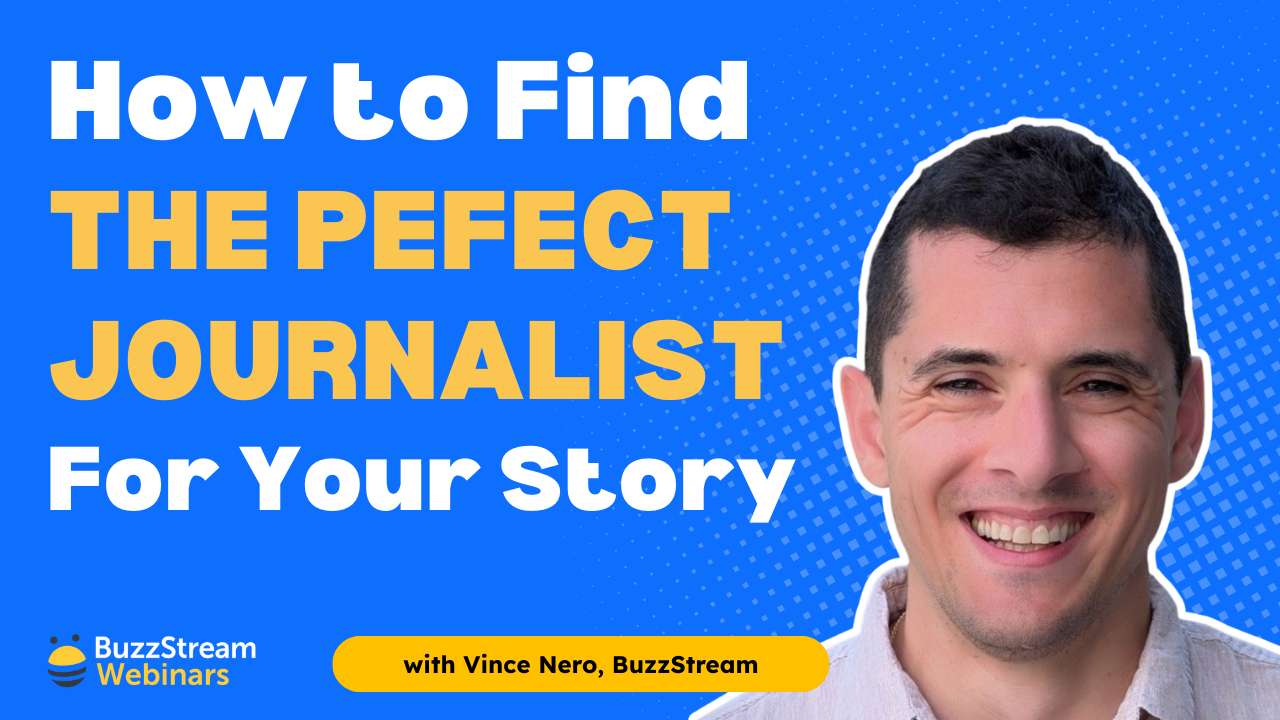Table of Contents
- Personalized pitching now outperforms mass outreach, especially under Gmail’s new anti-spam policies targeting bulk emails.
- Relevance is critical; try researching journalist bios, beats, and recent work before sending any pitch.
- Match subject lines to journalist headline styles to increase open rates and adoption in coverage.
- Journalists prioritize value for their audience, not promotional content—tailor pitches with data, quotes, and reader relevance.
- One follow-up email is ideal, preferably with a new angle or additional insights to re-engage interest.
Once upon a time, emailing journalists meant buying a list of media email addresses and blasting out a generic pitch.
Some call this the “spray-and-pray” technique. The technique seemed more cost-effective because it required less time and effort.
Ultimately, this approach worked…OK.
Some got coverage, but the vast majority of pitches were irrelevant, which decreased journalist receptivity to pitches overall.
This makes sense because the majority of emails they opened were basically spam. But the whole industry felt the carryover effect, making pitching journalists much more difficult for everyone today.
Luckily, the tides are turning against the spammers. Google now combats this approach by releasing new anti-spam requirements for bulk email sending.
Personalized email pitching is the key to success today. In this post, I’ll walk you through the process of pitching journalists, which will ensure lasting relationships and more coverage.
1. Find Journalists to Pitch
The first step is to find the right journalists to pitch.
I won’t get too deep into finding journalists here because I have already written a guide on finding journalists to pitch in a separate post.
But there are four easy ways to find journalists:
Google Search for Publications
If you don’t know where to start, you can also do a Google search to find some news outlets in whatever field you are interested in.
At the top of the search results, you’ll typically find news related to running. In the search results themselves, you’ll find publications.
Open these and look to see if they feel relevant to your pitch.
Search the Publication
If you know the publication you are looking for, or you’ve found one via Google search, you can then search the publication for relevant journalists.
Do this by going to relevant categories on the publication.
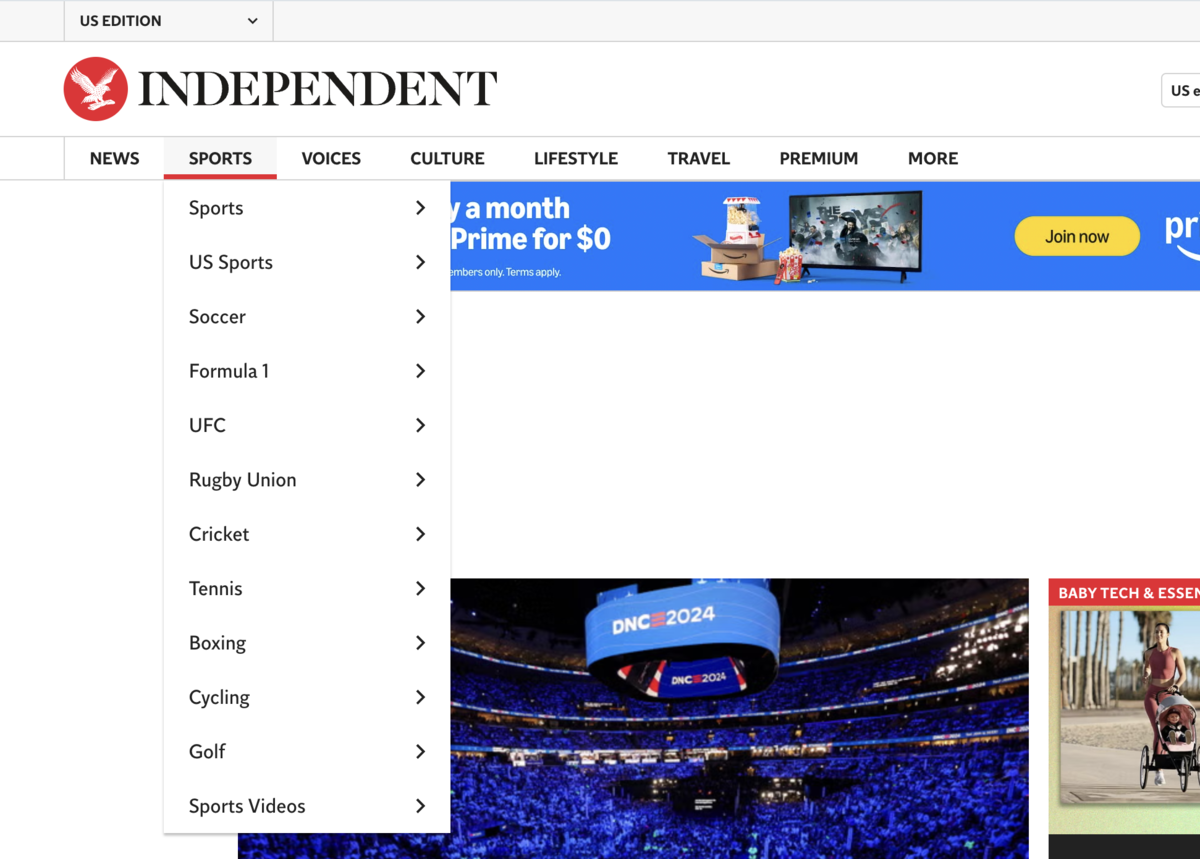
Or you might want to try a site:search, which will uncover articles in a specific publication about your topic.
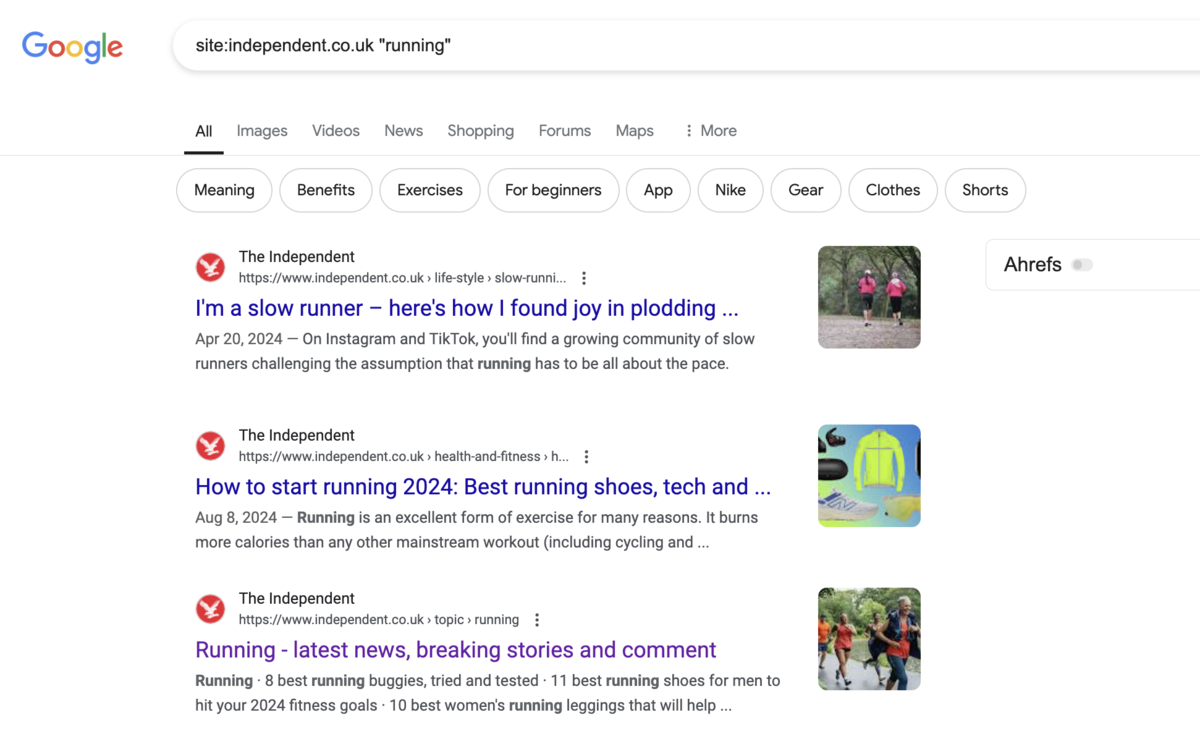
As you can see in the above, there are a few articles about running at The Independent. (Though realistically not enough where I would consider sending them a pitch about running.)
Google News Search
One of the more direct ways to find a journalist is by searching for Google News for similar articles.
Then, click on the post to find the journalist who wrote the article. This person becomes a potential journalist to pitch.
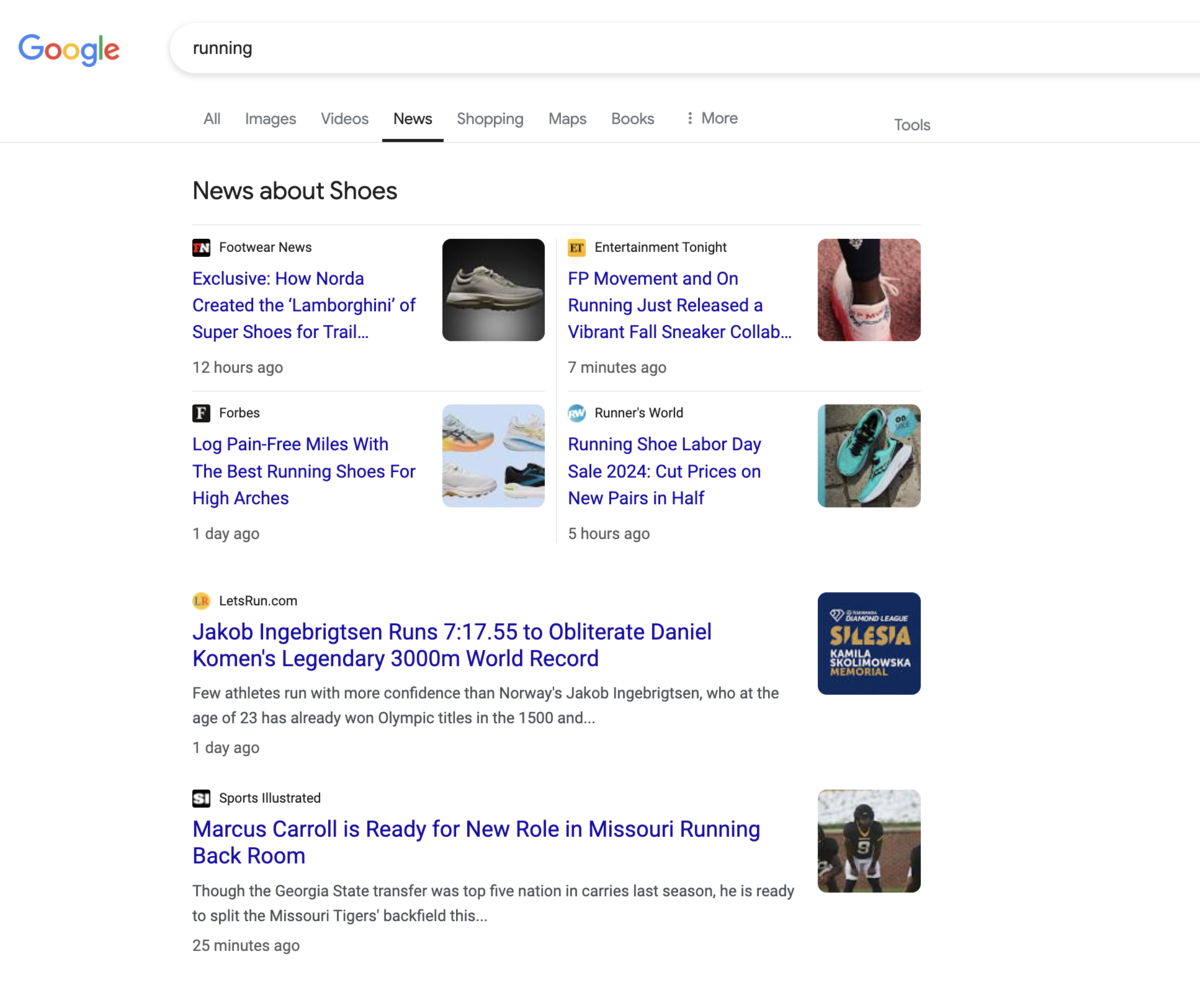
I like this best because you can find journalists who have written about a post recently. For instance, clicking on the first article in the search results I see a journalist named Jonathan Gault.
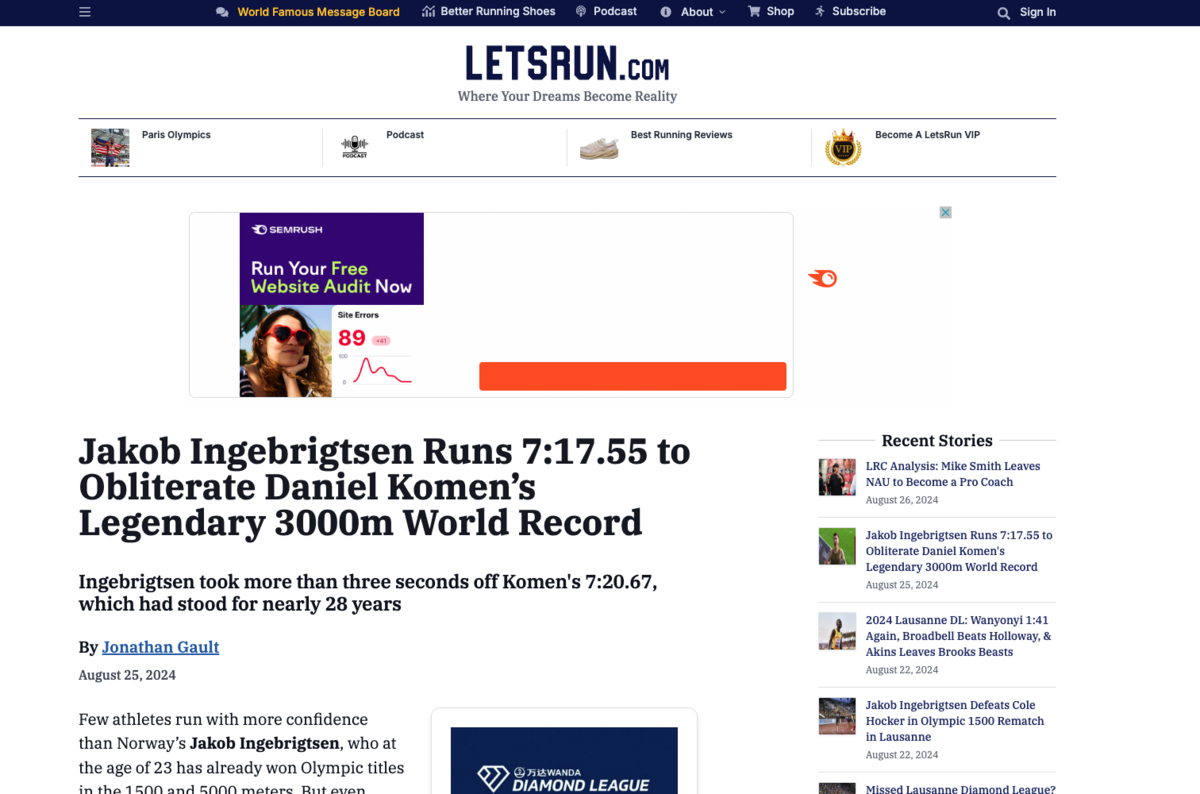
He requires a deeper look (more on this in the finding journalists post), but this approach gets me directly to a potentially relevant journalist.
Media Database Tool
Media database tools like Cision or Muck Rack can get you access to large lists of journalists.
Database tools allow you to search for journalists based on keywords, industry/beat, and publication name.
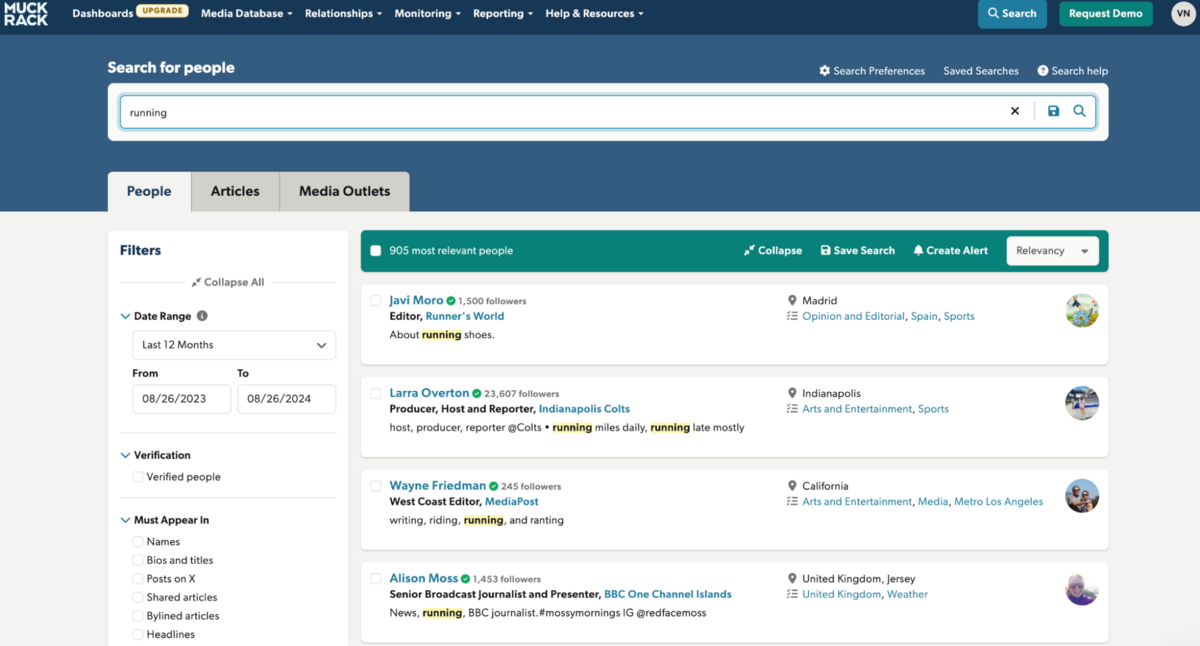
Although some media databases have staff devoted to manually updating their data based on journalist moves, it’s virtually impossible to catch all of them, so even the best databases still need verification.
ListIQ
Alternatively, you can use BuzzStream’s ListIQ to build media lists from Google News search instantly. (It also streamlines a lot of the steps below, requiring a lot less back and forth.)
After performing your Google News search, I enable ListIQ.
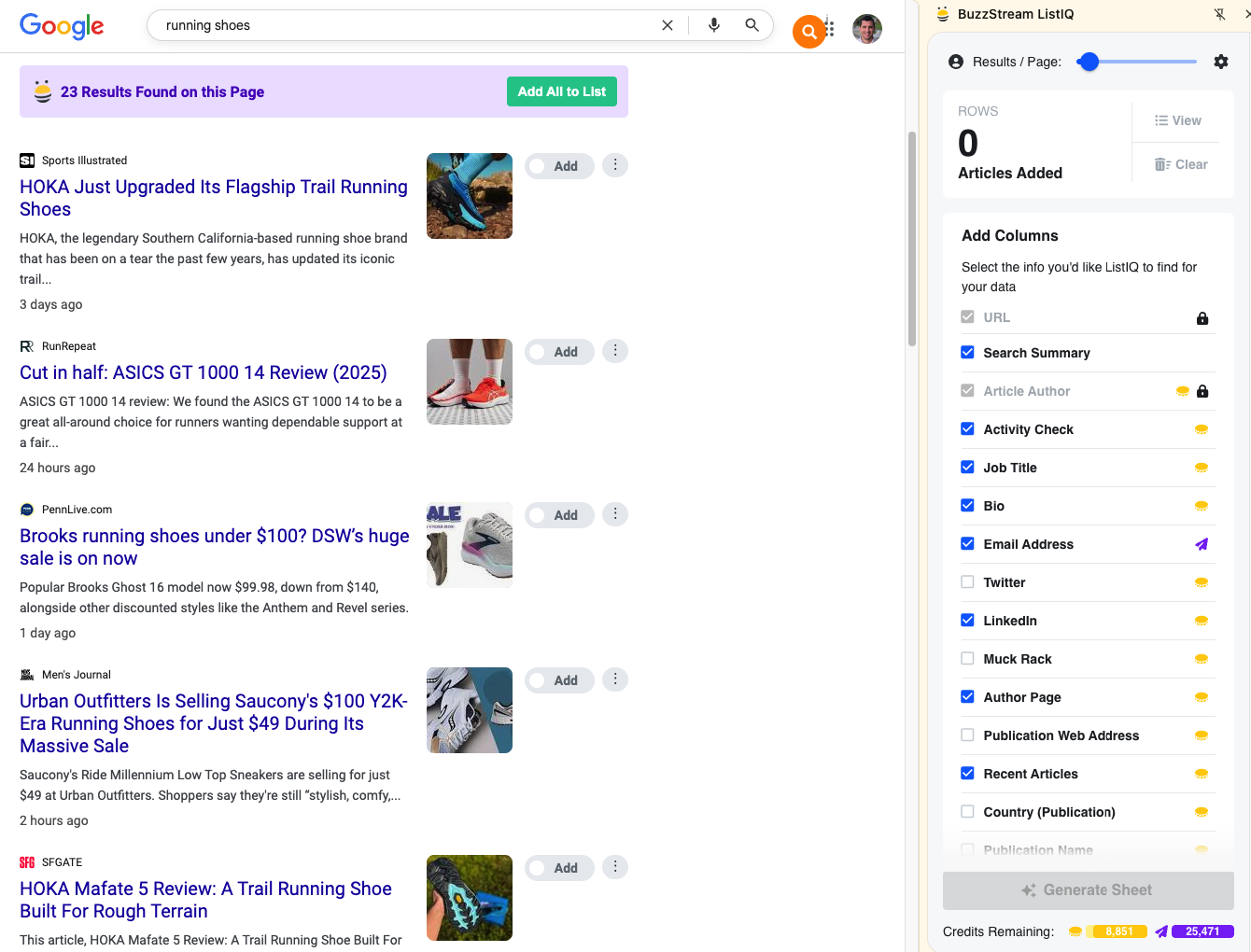
Then I select the information I want to pull from the article, like the journalist’s name, their bio, verified email address, recent articles, and even an activity check to tell me if the journalist is still writing at the publication.
It’s really everything I need to ensure that the journalist is relevant to my story, which as you’ll see in the next step, is key.
ListIQ delivers the information via CSV or Google Sheet so I can evaluate further.

Now I can evaluate relevancy without really needing to leave this sheet, which saves me a ton of time.
Next, I’ll cover why relevance is so important in 2025.
2. Ensure the Journalist is Relevant
Relevance is the key to success in pitching journalists.
As Alex Fitzpatrick, Data Editor of Axios, Former Editor at Time, put it to us,“Just make sure the pitch is relevant to the writer and actually something the writer would consider doing.”
Building on that, Cision’s 2025 State of Media report found that the number one reason journalists will ignore a pitch or block you is when the pitch isn’t relevant.
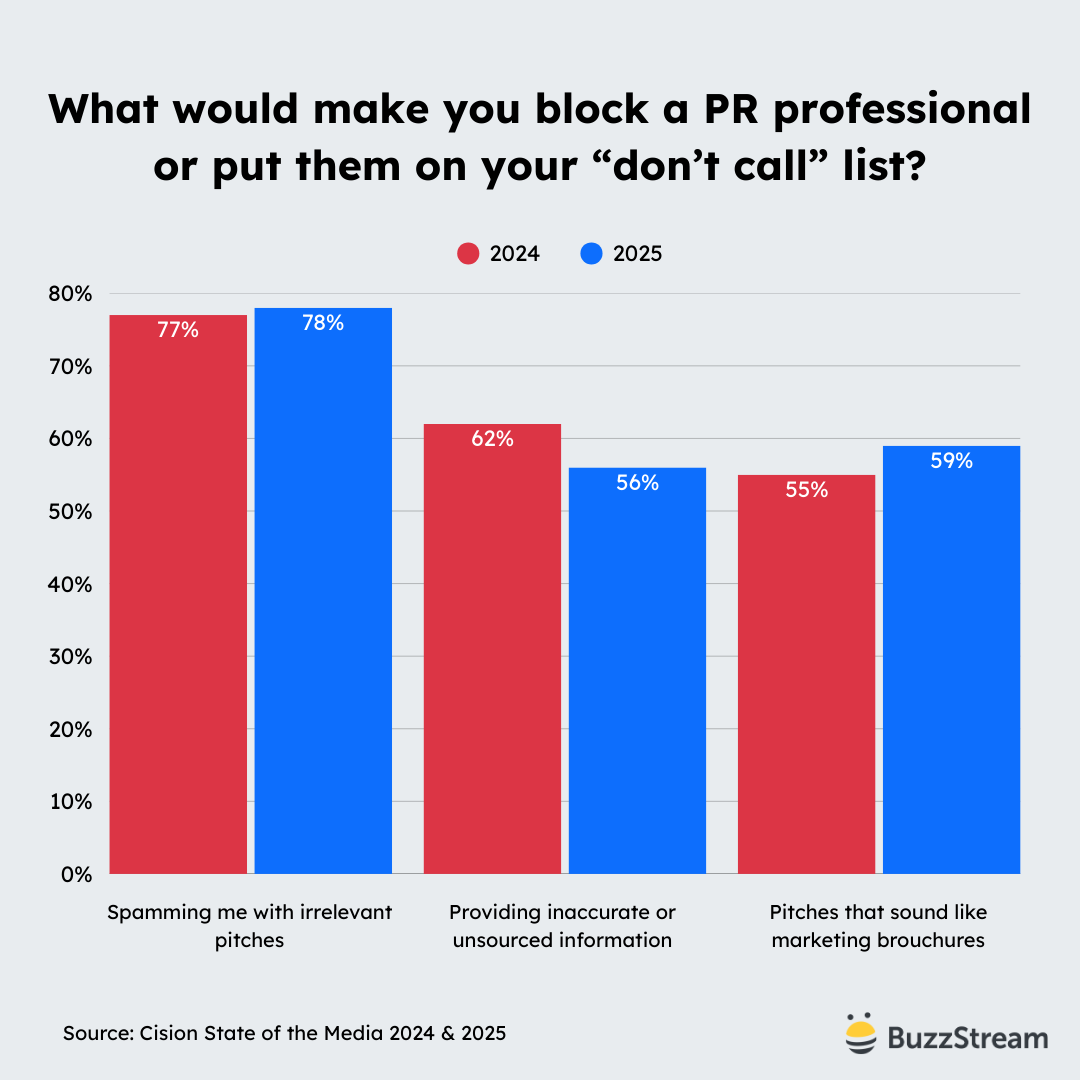
When tech journalist Natt Garun was still editor of The Next Web (now editor of YouTube), he told us, “…It’s imperative to do your research to make sure you are emailing the right person for what you’re looking for. For example, I exclusively handle guest contributions for The Next Web, so any email pitching news stories tend to go ignored by me until I have time to potentially respond.”
So, what does relevancy mean? In our post about how to contact reporters, I talked about some specific checks that you need to do when evaluating journalists:
- Do they still work there?
- Do they cover the same industry/beat?
- Have they covered the same topic recently?
However, Industry/beat means different things depending on who you ask.
For instance, let’s pretend we were trying to find writers willing to write about a nationwide charity race, like St. Jude’s Walk/Run.
A writer who writes about “running” may only review running shoes. That doesn’t mean they are interested in a pitch about a new charity race.
So, there are some checks you need to make along the way:
Read their Bio and Posts
The only way to truly understand relevance is to read their bio and at least a few recent stories. Most news publications feature a list of recent posts when you click on their author name.
For example, I found a journalist from Footwear News when searching for journalists who cover “running.”
The screenshot is Peter Verry’s author page, which lists his bio and several posts he’s written:
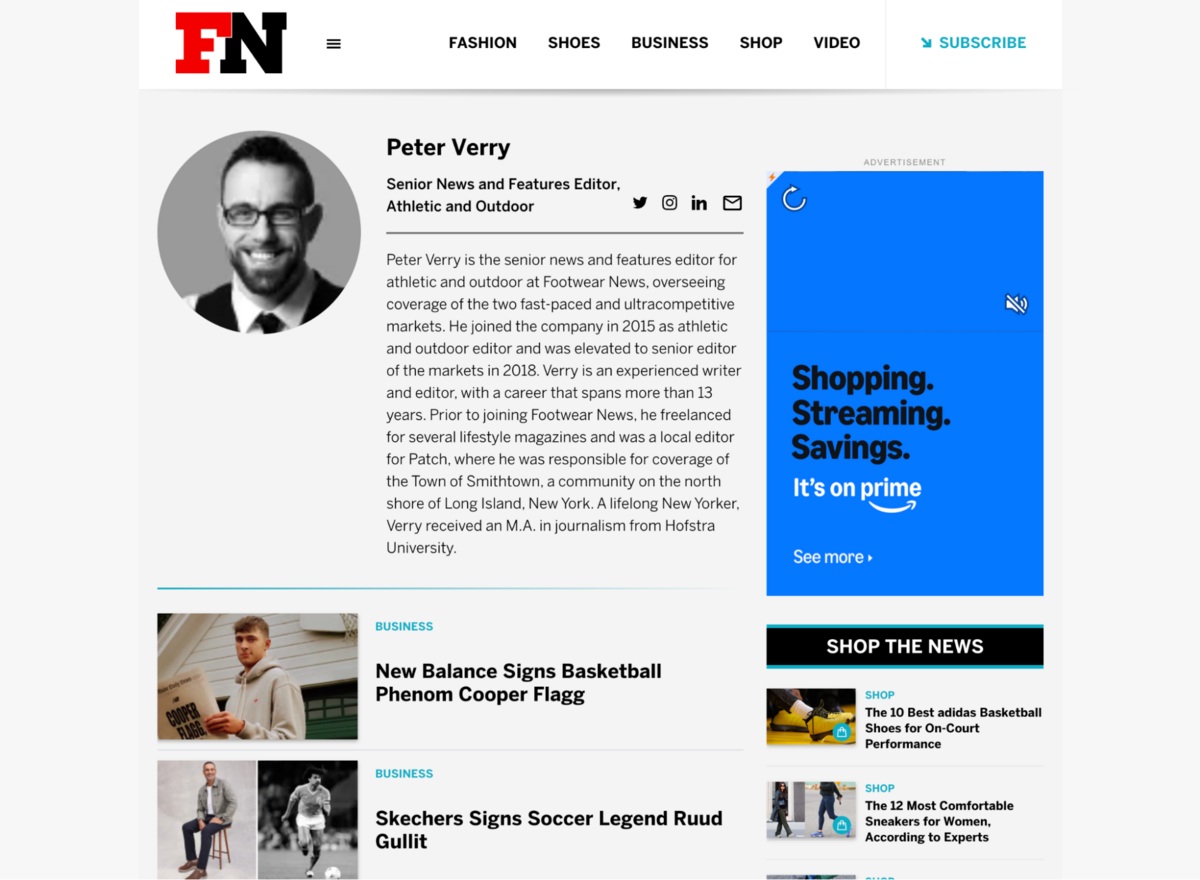
Based on his bio and a few recent posts for Footwear News, I don’t see anything about charity runs, so he may not be a great fit.
Conversely, here’s a journalist from the Philly Voice, Michael Tannenbaum, who has written about charity races.
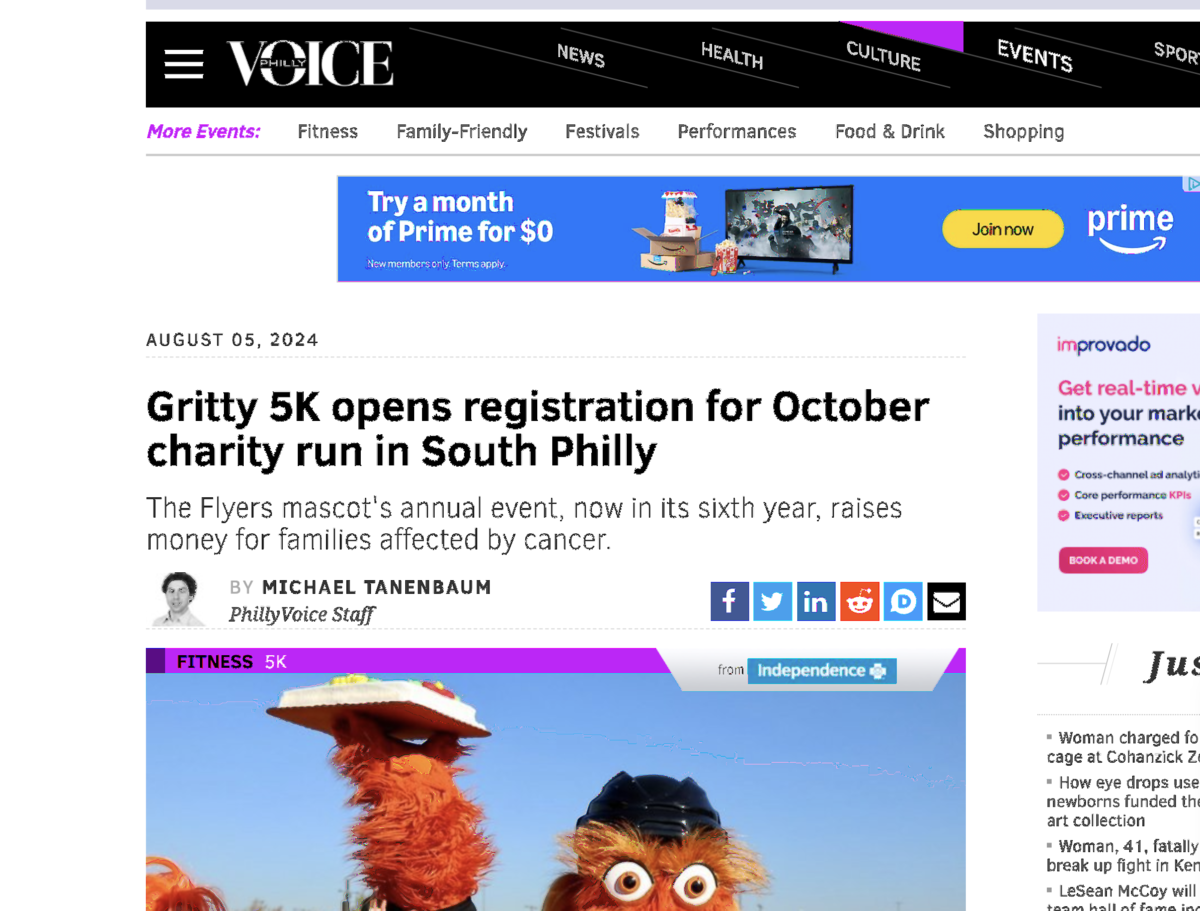
As you can see, Michael’s bio says that he covers community initiatives and cultural life.

Further reading of a few of his posts confirms that he covers regional news (SEPTA rail, Villanova news), so he could be relevant to this story.
Activity Check
Although this may be obvious, but another factor to consider is if the journalist still works at the publication.
You can typically do this by looking at recent posts’ dates, which you can typically see on the author page.
For instance, I can see that Michael’s latest articles are almost a year old (at time of publish), making him not a great fit anymore.
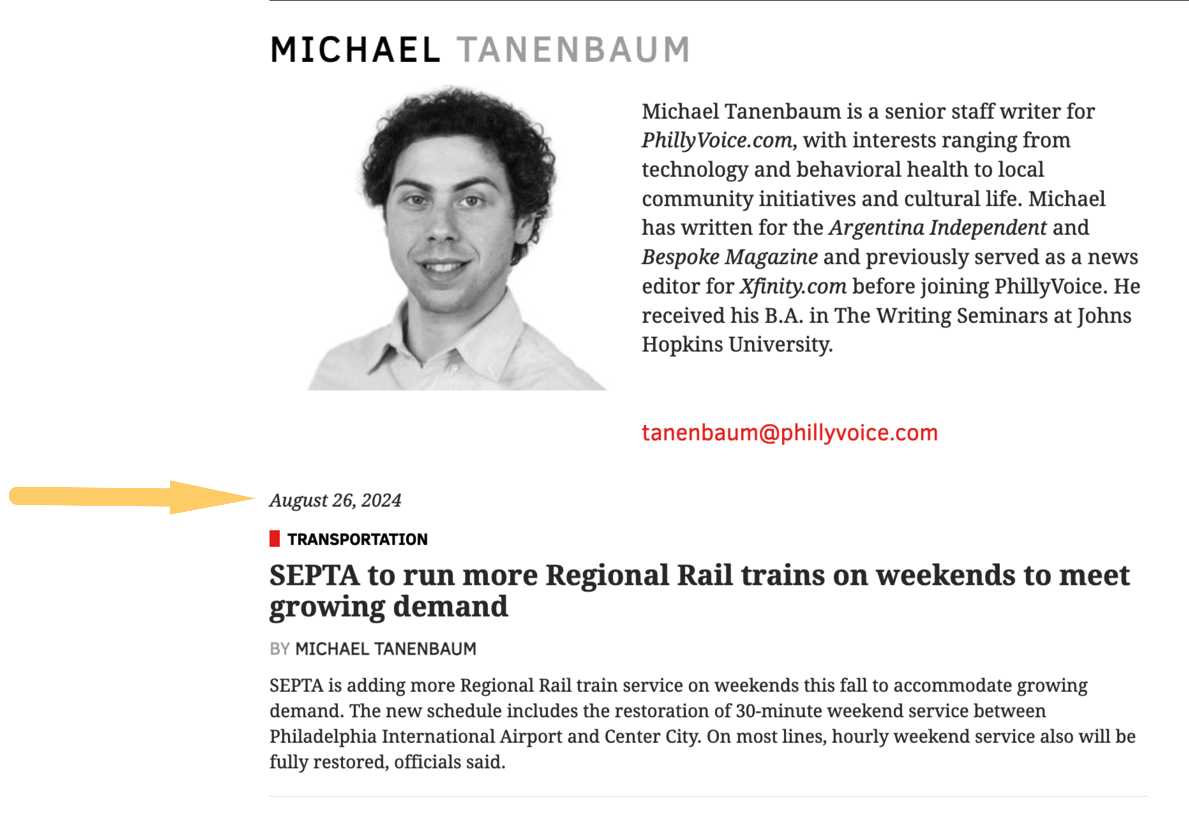
This is one of the key features that ListIQ helps me do at scale as well.
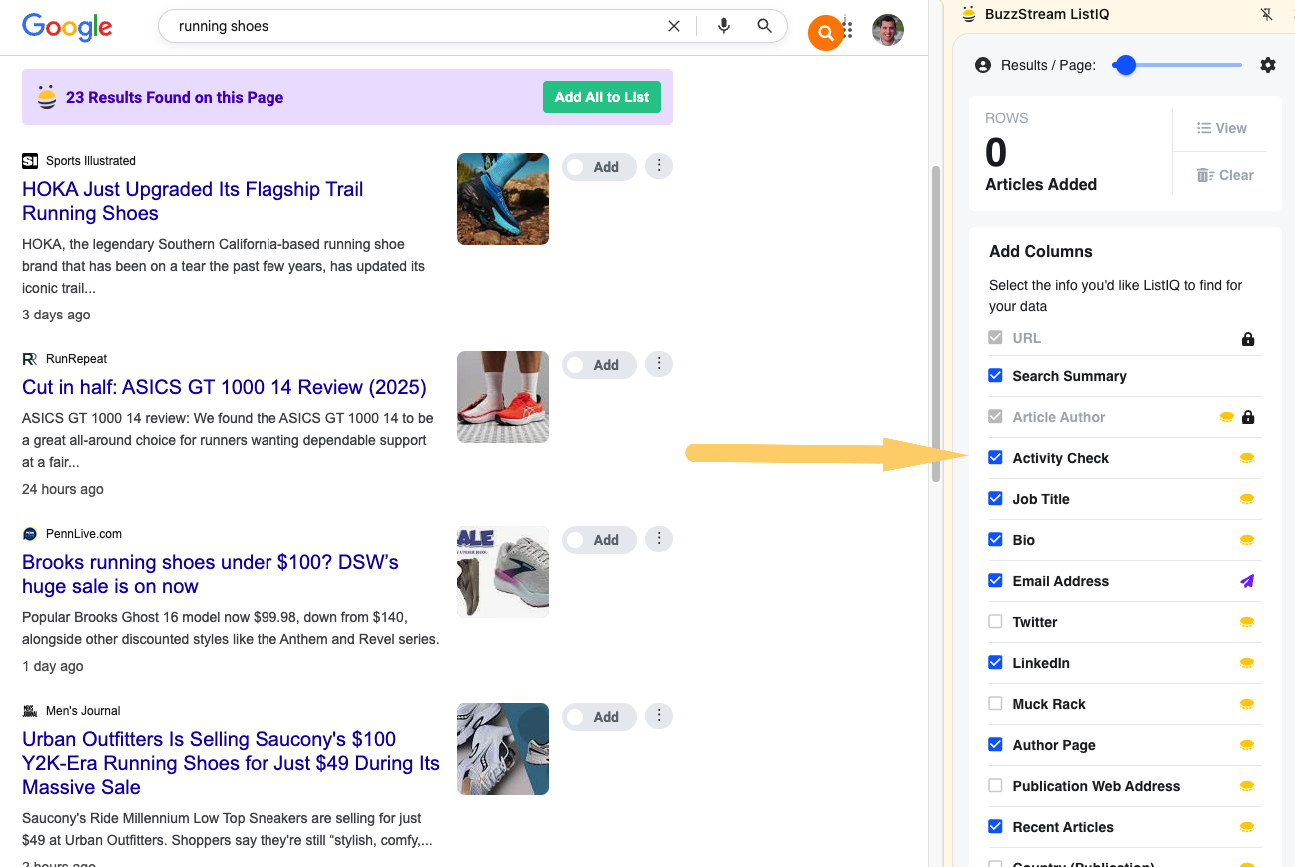
Once you find a journalist who fits the bill, it’s time to craft the subject line.
3. Match Your Subject Line With Their Headline Style
One of my favorite email personalization techniques is matching the subject line to your journalist’s headline writing style.
To do this, you can again head to the author page.
Let’s use a different example this time around. Let’s say we would pitch a city data study like the Wall Street Journal’s Top Tech Cities in the UK, and Norwich came in first place.
I found a journalist named Lily Boag from Norwich Evening News who covers similar stories.
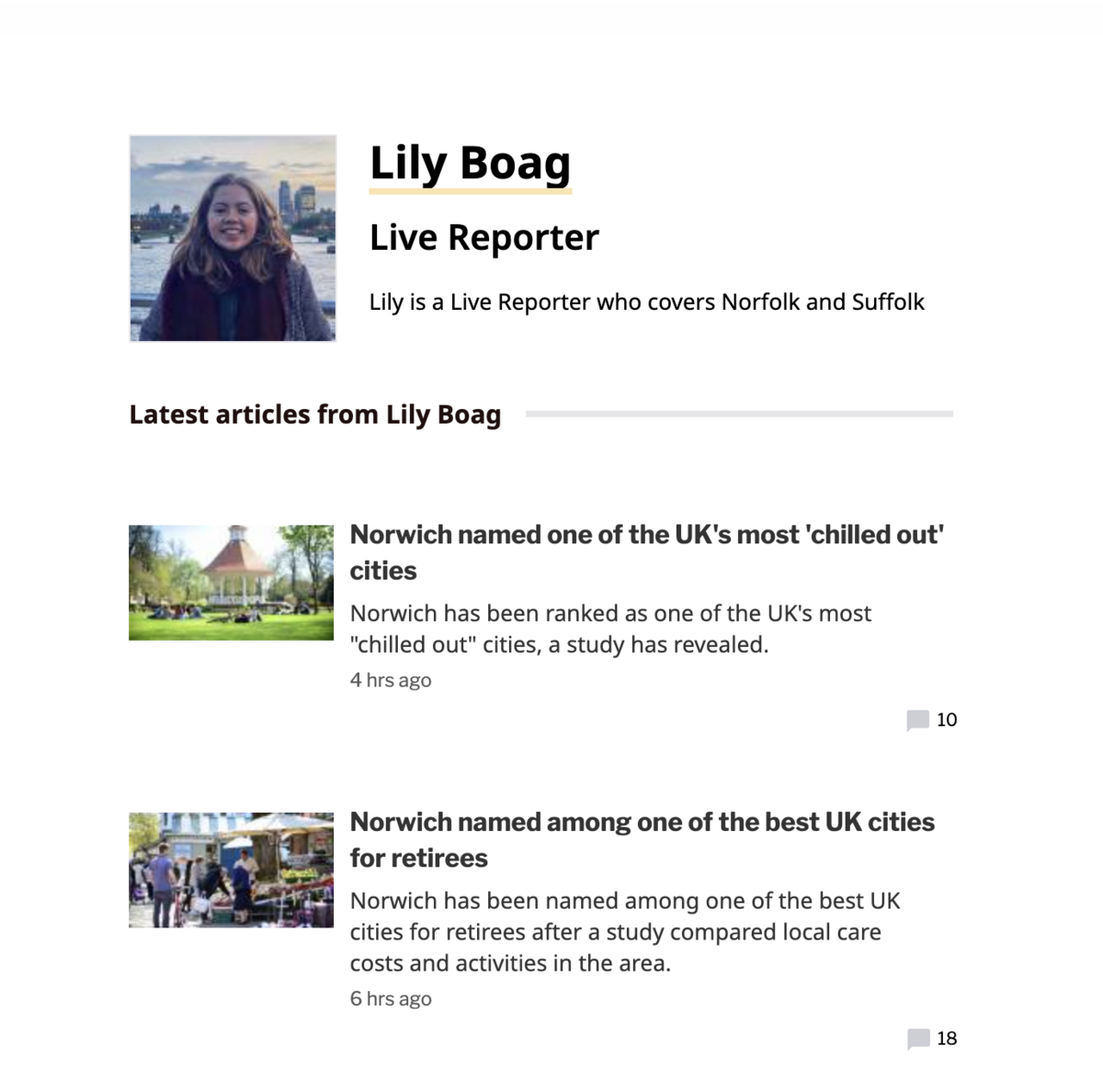
As you can see, she recently covered two city studies using the same format: “Norwich named X of the UK’s X cities.”
So, our subject line would match this structure: “Norwich named top UK city for tech jobs.”
When we interviewed Will Hobson, he mentioned how journalists reuse their subject line as the headline of their pitch.
And, when they do, it’s a signal that you did a great job writing your subject line.
“We’ve had a couple of journalists say to us that they’ve stolen our headlines. They’re like, ‘I love your headlines. We just copied it.” I was like, ‘oh, great. Love that. Great compliment.’”
With that in mind, I also recommend keeping the subject line short. Our most recent subject line study found that the ideal length is between 9-13 words.
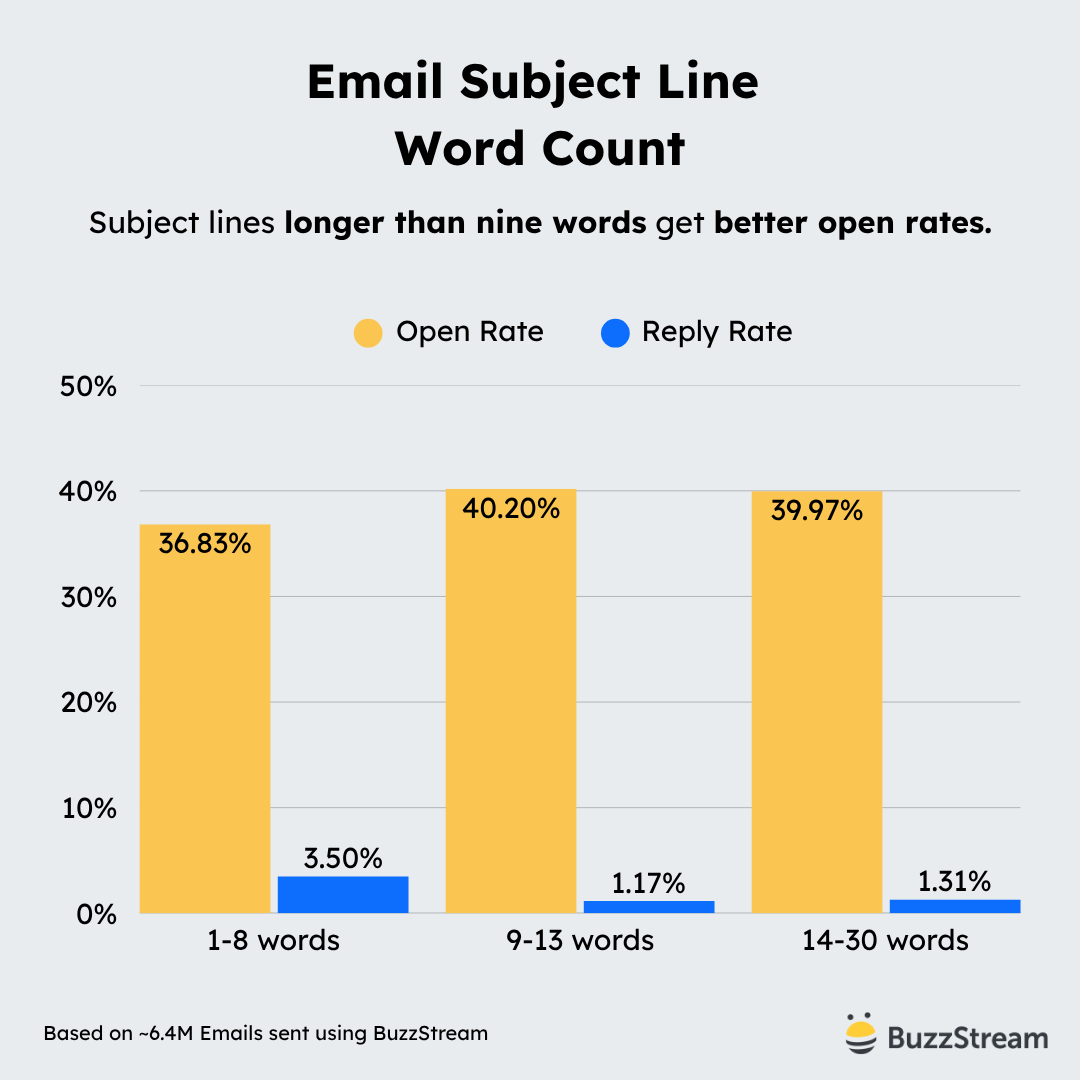
You can begin crafting your pitch once you’ve set your subject line.
4. Show Value (For Them and Their Audience)
If you’ve done your job targeting your journalists, it should be immediately apparent why your pitch is relevant to your journalist and their audience. But, the true value might not be as obvious.
While the subject line can also infer value, driving home the value of your pitch in the email body is critical.
Remember that journalists, like everyone, have goals and KPIs to meet. They need to drive clicks and views to their stories.
The real value of your pitch is what it can do for them and their audience.
According to Rich DeMuro, Tech Reporter for KTLA Los Angeles, the perfect pitch contains “stories that are sellable to my audience of consumer folks – regular people like moms and older folks – that will make life better, easier, and most of all – stuff that is readily available and affordable.”
To capture their interest, focus on how your story resonates with their audience to drive engagement.
Lauren Orsini, Tech Reporter, formerly of ReadWrite put it more bluntly. “Show me what your pitch has to do with my beat. Show me why your pitch is helpful/interesting to my readers.”
A lot of pitches are framed as asking me to “do a favor” or “help get some exposure to a deserving cause” and as harsh as it is to say, I’m a working professional, not a charity promoter.
Out of hundreds of pitches per week, I am only going to write the ones that help my readers, not the ones that help companies.
But there’s a fine line between value and coming off as too advertorial. Your email should sound like a pitch, not a marketing play.
Cision’s State of Journalism survey found that “pitches that sound like marketing brochures” are one of the top ways to lose favor with journalists.
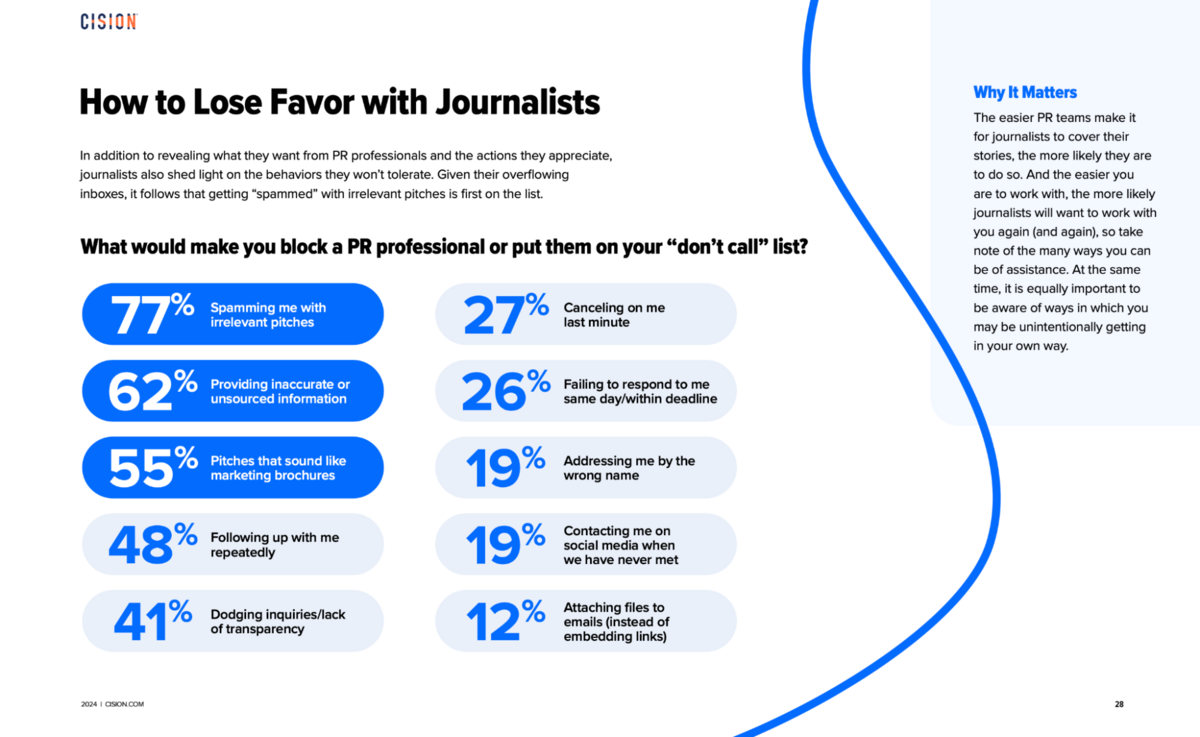
So, let’s look at a few examples of what this might look like in real-time.
Data Study Example
If you’re pitching to Teen Vogue magazine a new data study about credit card spending habits, focus on data bits that apply to teens.
Our latest study, conducted with over [X,000] participants, reveals surprising trends in credit card spending habit. Here are some major takeaways from the teenage participants:
- Subscription Overload: Teens are often subscribed to multiple streaming and gaming services, with many unaware of the costs, leading to an average of [$X] annually on unused subscriptions.
- Impulse Purchases: A significant [X%] of teens admit to making impulse buys due to targeted social media ads, showing how digital marketing directly influences their spending choices.
- Prioritizing Experiences: Despite economic challenges, [X%] of teenage respondents prioritize spending on experiences like concerts and travel over saving or essential purchases, reflecting a shift towards valuing experiences.
I’d be happy to share the full report or arrange an interview with our lead researcher.
…
Reactive Quote Example
Let’s pretend an expensive celebrity wedding is making waves in the news. Your client is a wedding planner, so you want to leverage this news with some reactive quote pitching.
Here’s how you could reach out to a journalist at People Magazine while focusing on the value to the readers.
Hi [Journalist’s Name],
With the recent buzz around [Celebrity’s Name]’s extravagant wedding, many couples are wondering how they can achieve a similar look without breaking the bank.
[Wedding Planner’s Name], a renowned wedding planner with over [X years] of experience, shares insights on creating a luxurious wedding without the hefty price tag:
- “Choose off-peak dates. Opting for a weekday or an off-season date can save you thousands on venue and vendor costs, allowing you to allocate more of your budget to those luxury details.”
- “Focus on key décor elements. By investing in a few standout pieces—like a grand floral arrangement or an elegant centerpiece—you can create a sense of luxury without needing to decorate every inch of the venue.”
- “Lighting is everything. Good lighting can transform any space. Using fairy lights, uplighting, or LED candles can create an elegant ambiance that feels both warm and high-end, making your wedding look lavish without the extravagant costs.”
These insights could inspire couples to create their dream wedding that feels just as glamorous as a celebrity event, but without the million-dollar price tag. If you’re interested in more advice or an interview with [Wedding Planner’s Name], please let me know!
In each case, the value is tailored to the journalist’s readers.
At this point, your work isn’t done yet. A big part of writing a pitch is ensuring that the journalist doesn’t have to do much work at all.
5. Provide All of The Necessary Information
Journalists don’t have much time. So, the best pitches are the ones that allow a journalist to get right into writing their story without asking for more data or information.
Dan Seifert, Deputy Editor of The Verge says..”it’s always easiest for me (in terms of time and such) if the bulk of the information in the pitch is provided immediately, as opposed to a teaser that makes me ask for the actual information.”
(Special thanks to Kevin Raposo for sourcing all of these journalist quotes for us, by the way.)
So, what important information does a journalist need in your pitch to write their story?
Media
Most journalists prefer to have some kind of images included in their pitches.
You can include these in-line or as attachments.
Based on Cision’s study, we can see that images were the overwhelming winner of the most useful multimedia element provided by PR professionals.
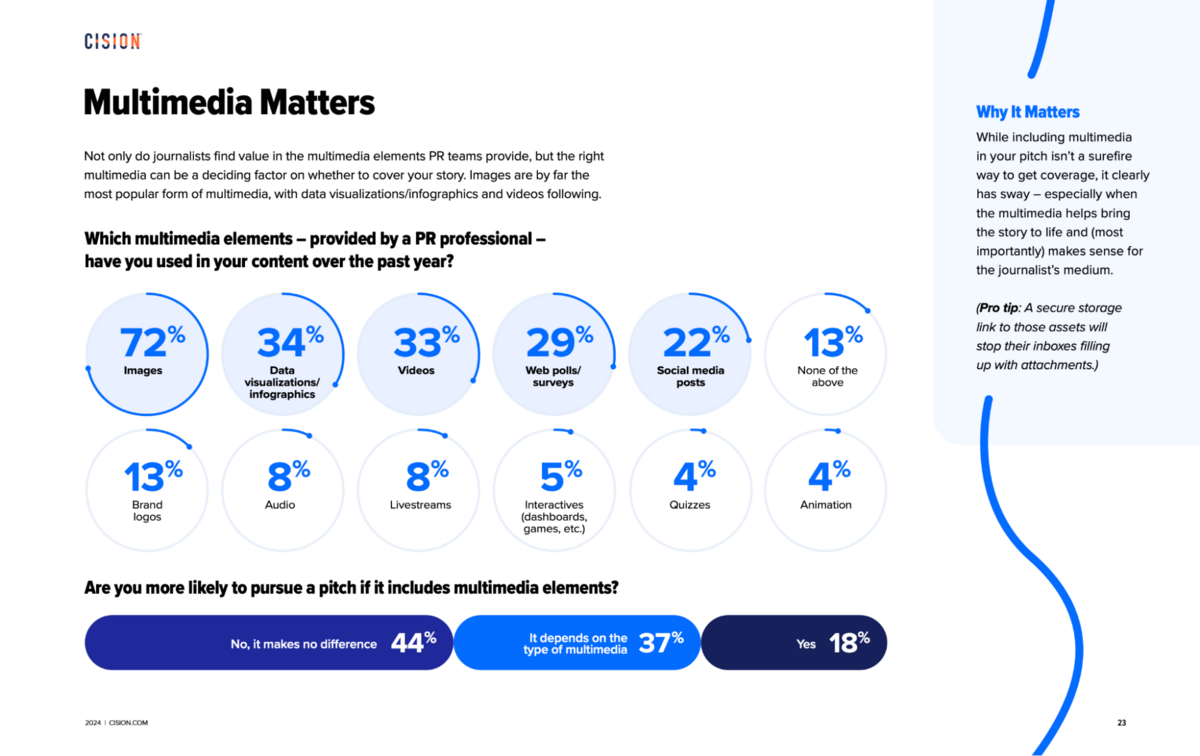
As you can see at the bottom, it’s not always necessary, as 44% of journalists say it makes no difference whether they pursue a pitch.
Expert Quote
Expert insights are becoming a necessity these days. With the amount of AI misinformation and fake news out there, journalists have been using more and more expert quotes to help support their stories.
Plus, from an SEO perspective, Google has often talked about how sites should focus on displaying E-E-A-T or expertise, experience, authority, and trust.
So, including a quote or quotes for them to use can save them a lot of time and make your pitch more turn-key for the journalist.
I recommend including at least one quote from your CEO or another prominent thought leader at your company who can support your pitch.
However obvious this sounds, make sure that the journalist will view the expert you’re promoting as a legitimate expert.
Boilerplate
The boilerplate is information about the pitch’s source. For example, a boilerplate for BuzzStream might look something like this:
About BuzzStream
BuzzStream is a premier outreach and relationship management platform tailored for digital marketers, PR professionals, and content creators who need to build authentic connections and manage large-scale outreach campaigns. With BuzzStream, users can efficiently discover contact information, send personalized outreach emails, track communications, and measure the effectiveness of their link building and digital PR efforts. By simplifying these critical tasks, BuzzStream empowers teams to increase their online visibility, generate high-quality backlinks, and build lasting relationships with influencers, bloggers, and journalists.
Headquartered in Austin, Texas, BuzzStream is trusted by thousands of brands, agencies, and enterprises around the world. For more information, visit www.buzzstream.com.
My best advice for your boilerplate comes from my podcast conversation with Mark Rofe.
“I’ll kind of make sure I’ve got some keywords…(in the) little “about” section about the company just to be on the journalist radar.
In case they want to get in touch in the future, it makes me more findable.”
Basically, you want to make your pitch easy to find. They may bookmark your email and come back to it later.
Data
Trustworthy data isn’t just for data-led stories. In fact, most pitches benefit from data backing up your claims.
For example, say BuzzStream was releasing a new digital PR course.
In my pitch, I might want to cite some data explaining why digital PR is trending right now.
Hi [Journalist’s Name],
With 73% of marketers now favoring digital PR over traditional methods for brand visibility and quality backlinks (Content Marketing Institute), the need for advanced digital PR skills has never been greater.
As someone who covers the latest in marketing trends, I thought you’d be interested in BuzzStream’s new Digital PR Mastery Course, designed specifically to help PR professionals stay ahead of the curve.
…
As you can see, data can help a journalist understand the context of the story pitch, increasing the likelihood of it getting picked up.
Pitching Data-led Stories
When pitching data-led stories, focus on the most relevant and eye-catching data. Three to four data points are typically all you need to include to tell a story.
For example, if I’m providing data points for a drunk driver study in Tennessee to a journalist in Memphis, I might focus on the main takeaway and two or three supporting statistics.
Hi [Journalist’s Name],I wanted to share some findings from our latest study on drunk driving trends in Tennessee. With the holiday season approaching, the data highlights a critical issue that could help drive awareness and potentially save lives for Memphis drivers.
- Significant Increase in Drunk Driving Incidents: Our study found a 15% increase in drunk driving incidents in Tennessee over the past year, with a noticeable spike during the summer months.
- Young Drivers Are Most at Risk: Drivers aged 21-30 accounted for nearly 40% of all drunk driving incidents, making them the most at-risk age group.
- Weekends Are the Deadliest: Over 60% of all alcohol-related accidents occurred on Friday and Saturday nights, with incidents peaking between 11 PM and 3 AM.
…
As you can see, the bulleted and bolded approach makes this easily scannable for the journalist.
Unsure about all of the above? You can use your target journalist’s existing stories as your guide on what to include in the pitch.
Here’s how.
Match Your Pitch Format to a Similar Story
In her media pitch post, Hannah Smith explains that the easiest way to understand what a journalist wants in a pitch is to find a similar post written by the same journalist.
Then, you can work backward to include those necessary pieces.
For example, you may want to pitch news about your company’s earnings to CNBC. I found this piece by Ryan Baker of CNBC, about how Wingstop is outpacing other fast food competitors.
The piece opens with a connection to a similar story written by CNBC, some expert quotes, and some critical data points about Wingstop’s growth.
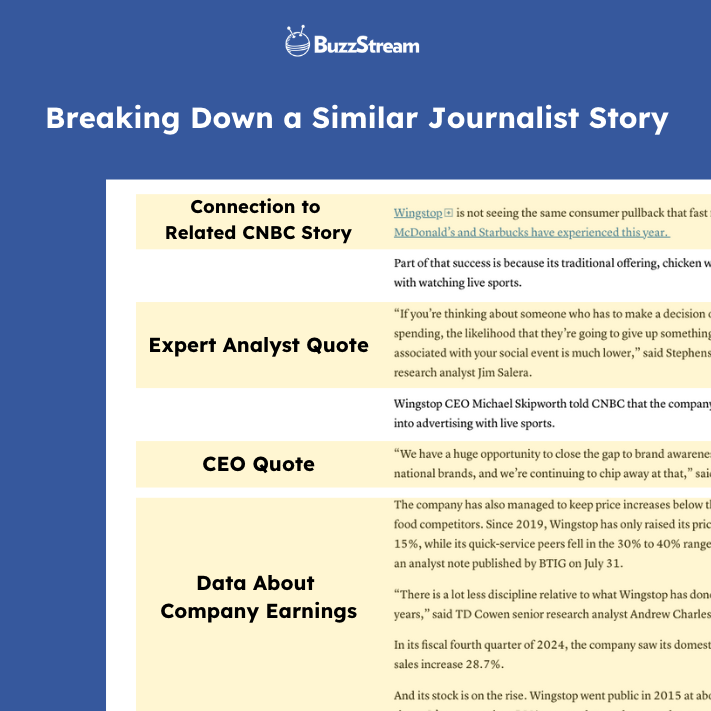
So, if we reframed this as a pitch, it might look something like this:
Hi [Journalist’s Name],
You covered a story last week about how Wingstop is thriving at a time when Starbucks and McDonalds have seen massive pullback.
I had another success story that I thought your audience would be interested to hear about BrewSpot, a rapidly growing coffee and casual dining chain that has shocked the market experiencing:
- 60% year-to-date stock price surge—a historic rate in this industry
- 35% increase in same-store sales in the first half of 2024
- 20% increase in overall revenue compared to the same period last year
- 50 new locations opened in the last 12 months
Based on said financial analyst Robert Greene of Market Insights, their growth is due to:
“BrewSpot’s growth has been fueled by its ability to blend affordability with a premium customer experience. Their strategic focus on local community engagement and sustainable practices has created a loyal customer base, driving impressive sales growth even in a challenging market.”
CEO Emma Larson says:
“BrewSpot is more than just a place to grab coffee; it’s a community experience. Our focus on quality, sustainability, and customer loyalty has helped us thrive, even when others are seeing a decline.”
These strategies highlight how BrewSpot is navigating market challenges and driving customer engagement. Would you be interested in covering BrewSpot’s success story?
About BrewSpot:
BrewSpot is a forward-thinking coffee and casual dining chain founded in 2010, dedicated to providing high-quality coffee and fresh, artisanal food in a welcoming atmosphere. With over 200 locations nationwide, BrewSpot prides itself on its community-focused approach and commitment to sustainability.
Writing like this is a great exercise for thinking like your target journalist. However, you can take this one step further.
The next section will show you how to ensure you give all the necessary information.
Try to Write An Article From Your Pitch
As a PR, you should provide all the information a journalist needs to write a post. To truly know that you are giving all of the information needed, you can really put yourself in the driver’s seat.
In our podcast interview with digital PR expert Hannah Smith, she recommends what I’m calling the 15-minute Exercise.
I’ll have Hannah explain:
“I’ll look at my pitch, and be like, could the journalist write this story in 15 minutes just using my pitch? …And wherever I get stuck, that tells me this is something the journalists need, right?
I don’t necessarily recommend trying to write an article (although Hannah did say that she actually does occasionally), it’s simply an exercise or evaluation criteria to make sure that you are giving enough information for a journalist to write their piece without needing to come back to you for more.
Overall, a pitch may look like this:
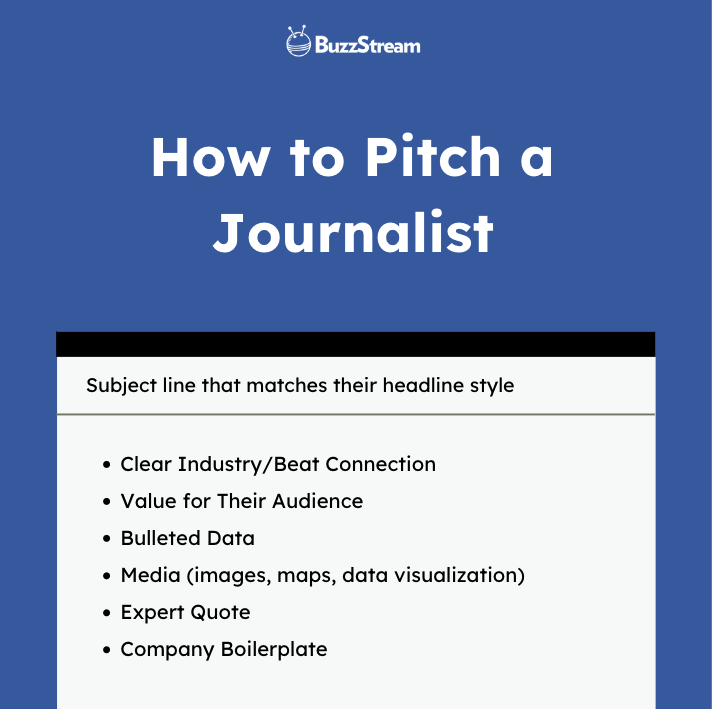
Always Follow Up (Once)
Follow-up emails probably get the most heat out of any PR activity.
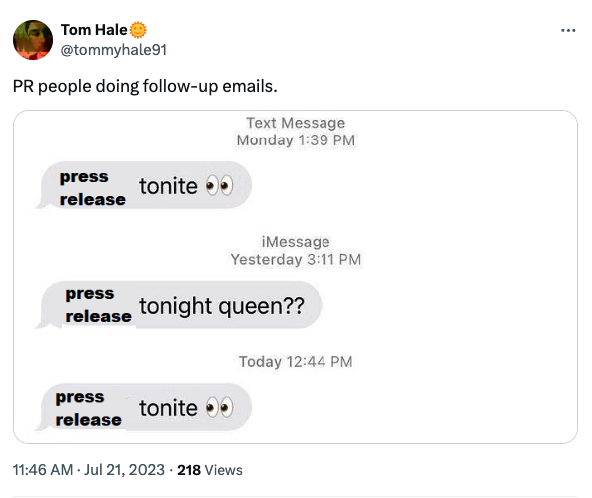
The issue isn’t that journalists don’t want follow-up emails; they can be productive. The problem is when they get too many too quickly.
The overwhelming majority of studies dictate that one follow-up is all needed, including Cision below.
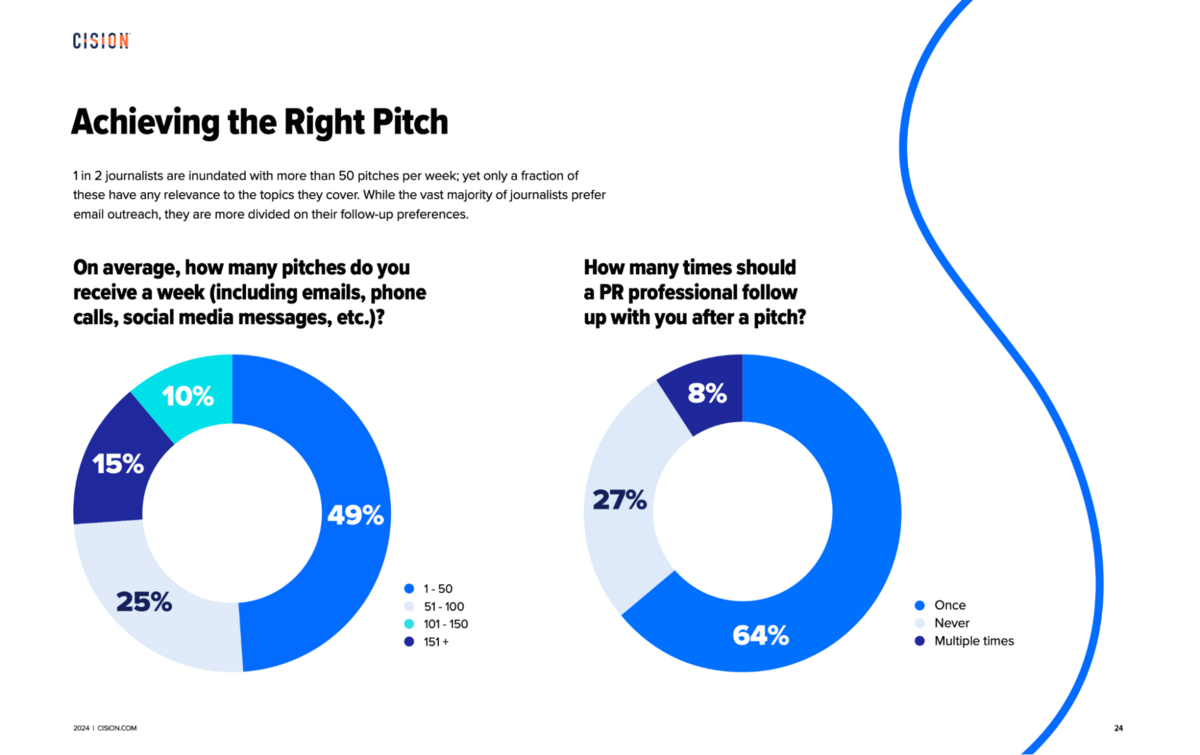
In terms of timing, follow up 4-5 days after the initial story.
Standard Follow-Up Example
A standard template to follow up on your journalist pitch might look something like this:
Hi [Name],
I am following up to see if you had a chance to view [my request/link/my email]. As a reminder [recap the ask in one sentence].
I’d love to know what you think.
But, some of the more effective forms of follow-ups are those that change the angle, reference new stories written by the journalist, or pitch new data.
Try a New Approach
In our email outreach template post, Gisele Navarro from NeoMam Studios recommended using the follow-up pitch as an opportunity to try new angles.
She will sometimes conduct additional research or analysis to uncover new findings.
“When you follow up with unresponsive targets, you have nothing to lose. Make your follow-up emails count by trying new things beyond the ‘Just following up on the story I sent last week.”
While this approach may be more time consuming than the standard approach, I’ve found that it works much better.
If time is an issue, you can only focus on following up with the journalists who have opened your email several times.
Creating a Pitch Template in BuzzStream
Once you have a sense of what to include in your pitches, you can work them into templates.
I typically create several templates in BuzzStream based on angles, industries, or journalist type.
For example, if I’m pitching our BrewSpot story, I might have a template that focuses more on the history of stock price surges.
In another, I might pitch to marketing blogs to focus more on the tactics that BrewSpot took to achieve its massive growth at a time when competitors were floundering.
To create templates in BuzzStream, click on the Sequences tab.
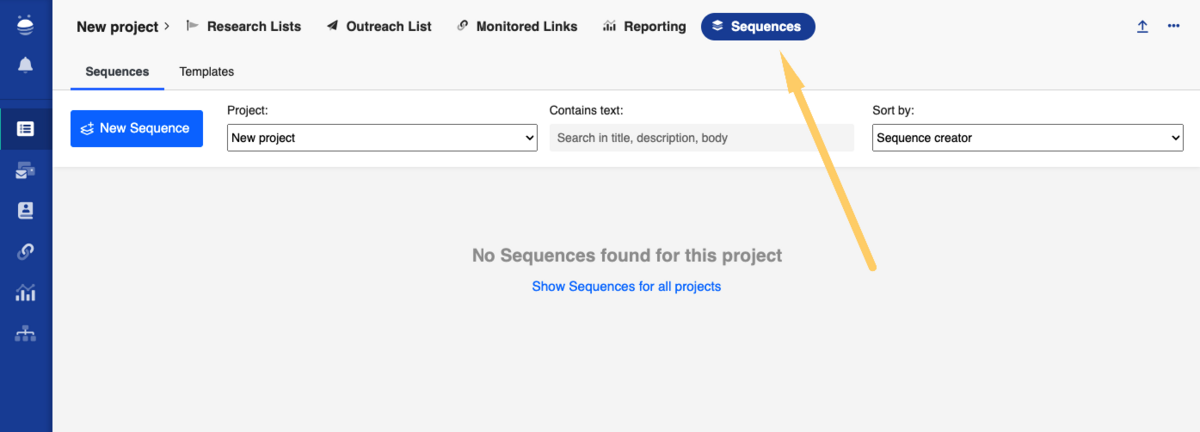
Then you’ll have the option to create sequences or individual templates. Click on Templates, then New Template.

When I create templates, I use the Dynamic Fields on the right to speed up my process.
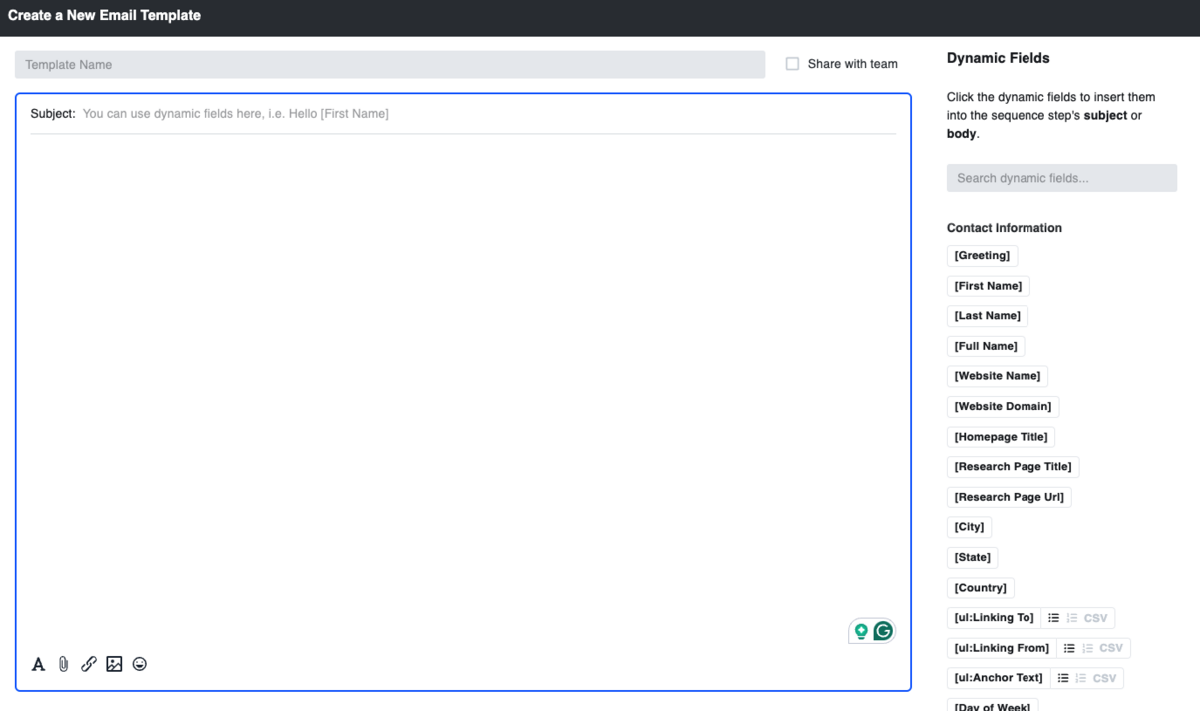
I’ve pasted in the template for our fictional restaurant, BrewSpot.
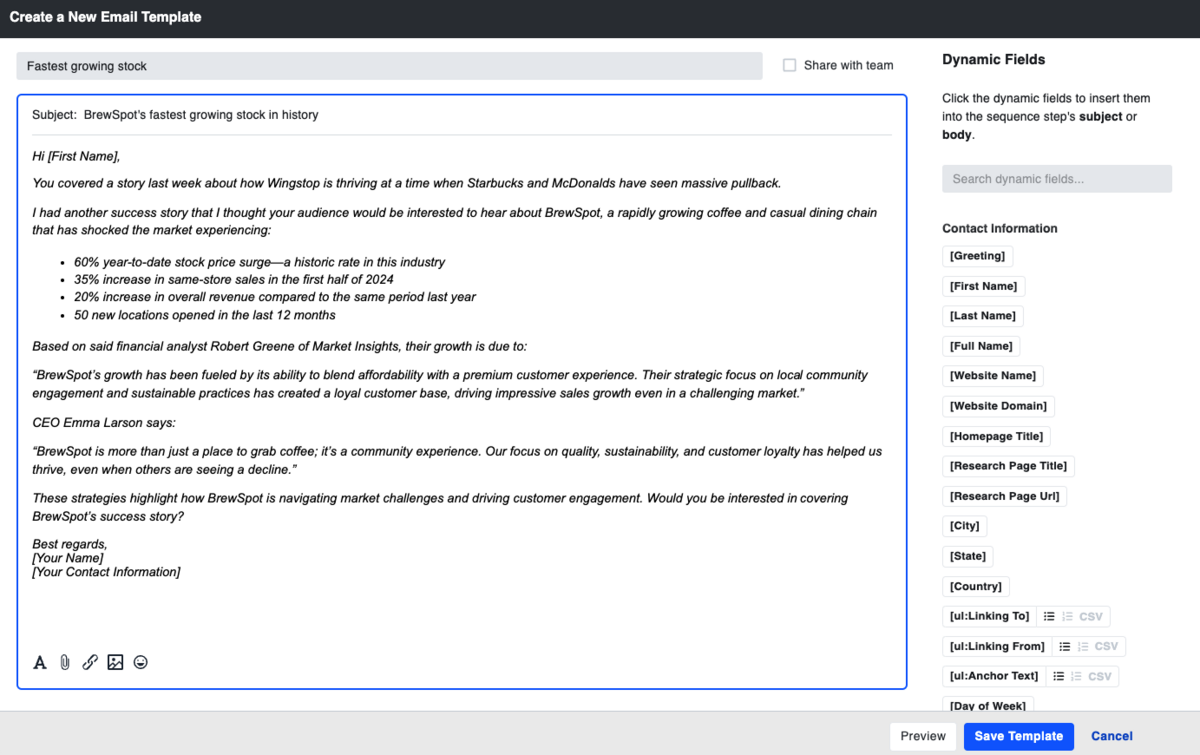
Then, maybe I want to create a template using a different pitch angle.
I’ll save this template for later and create a new template, this time with an angle that I can pitch to marketing journalists.
So, I’ll name the template “marketing angle.”
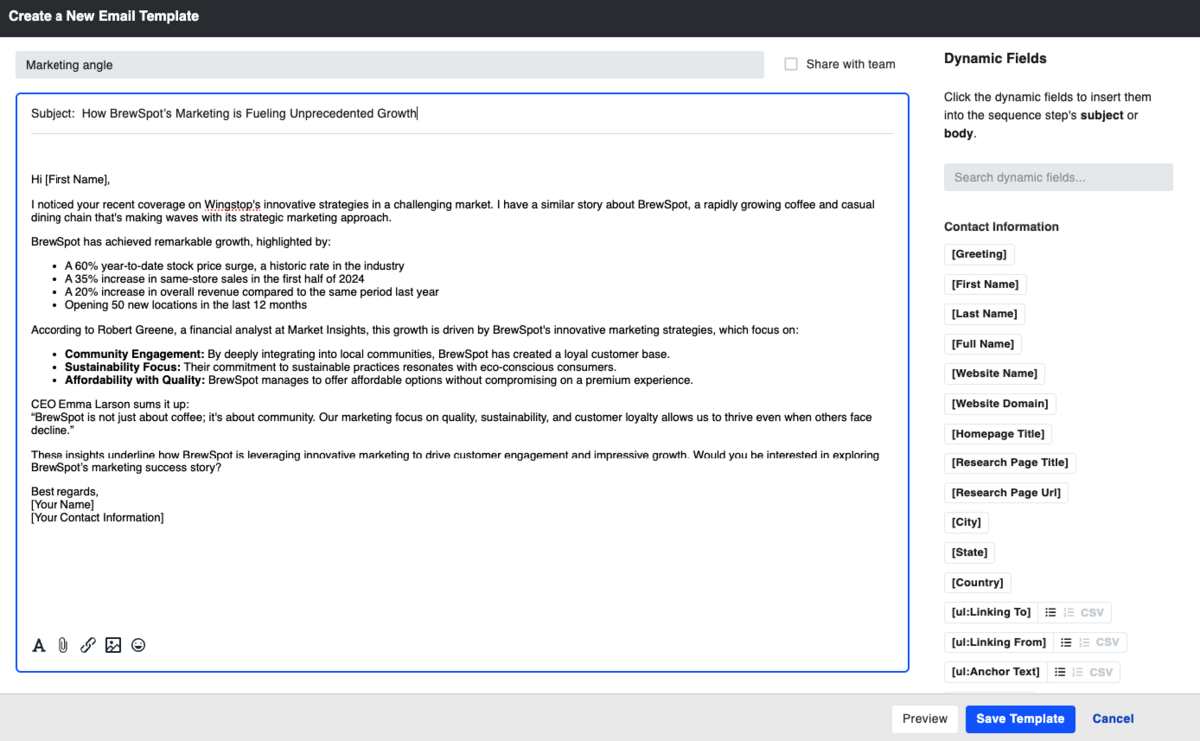
I’ll save this one and create one last template that I can use for follow-ups and name it “Follow up”.
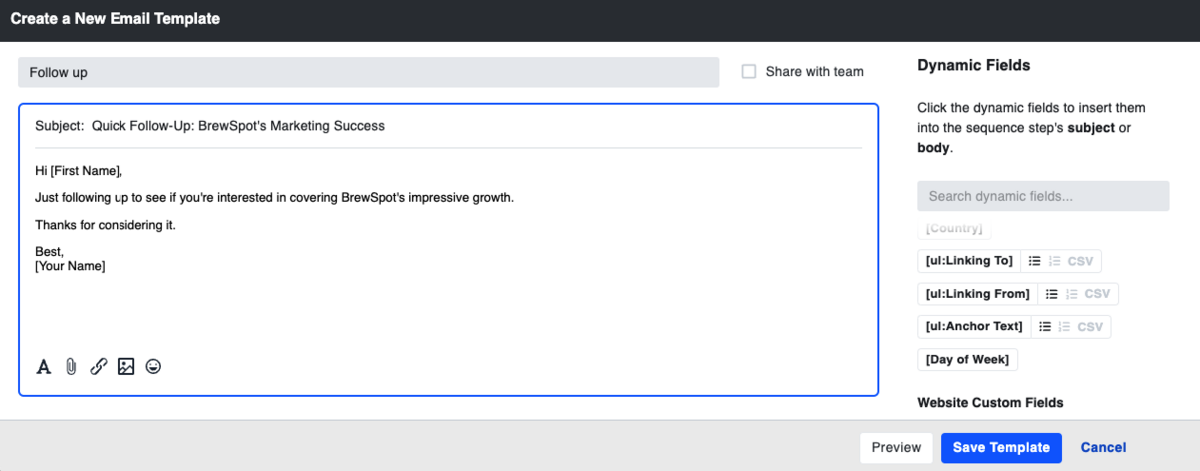
Now, if I want to create Sequences, I have all of the templates that I need.
I’ll click on Sequences tab and New Sequence:

Next, I click on the copy button, which will allow me to bring in any existing templates.
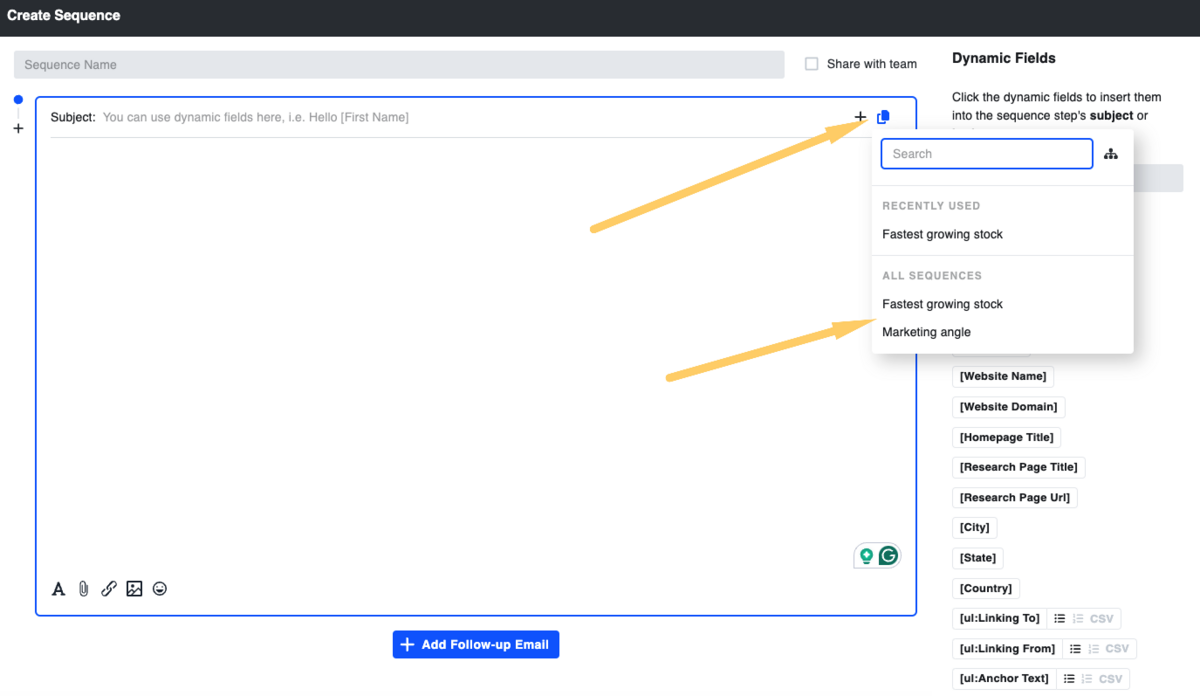
Then I’ll click on Add Follow-up Email and follow the same steps to copy in my pre-existing follow-up template.
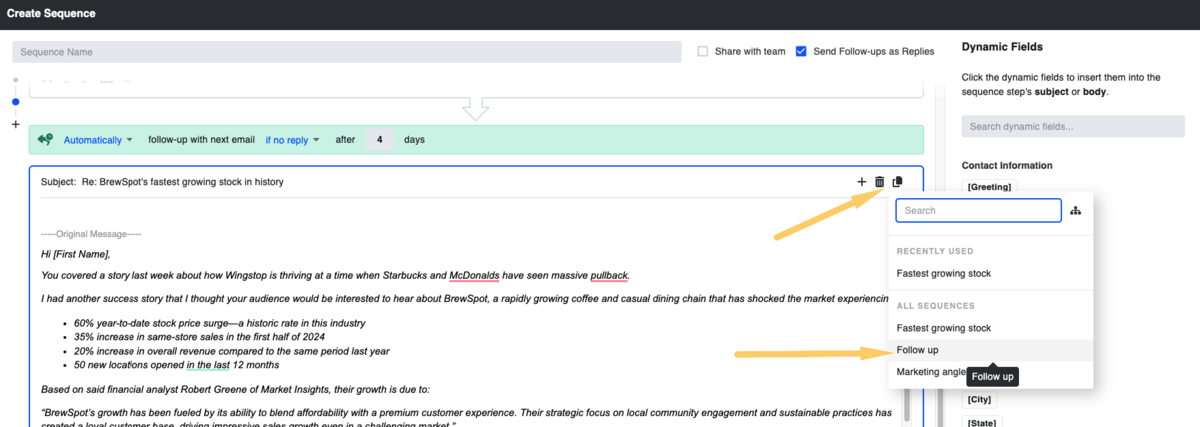
Then I’ll name the sequence so that I can pick it out later.
Then, when I’m in my outreach phase, I can choose whatever sequence or template I’ve created.
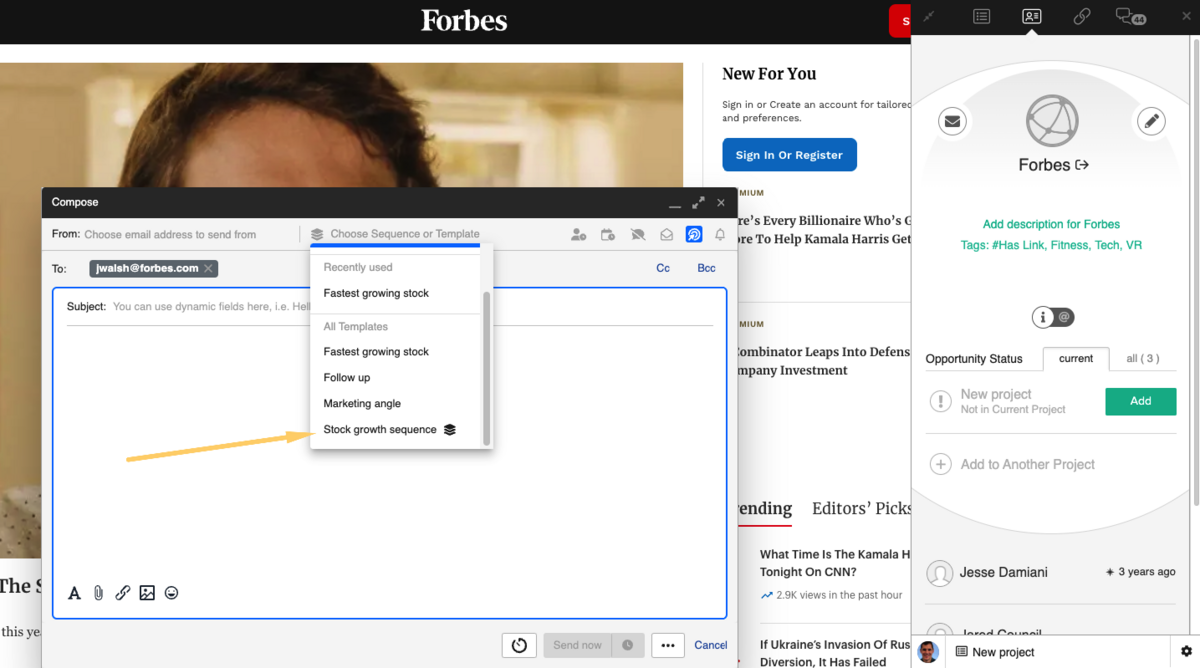
There’s no limit to how many angles, templates, or sequences you can create.
Some of our customers create tons of detailed templates so that they don’t have to do any work when it comes time to send the emails.
Check out our post to find several more examples of email outreach templates.
Build Relationships, Not Links
There are many ways to approach your email outreach to journalists; some are more time-consuming than others.
And although email personalization can seem more time-consuming, it’s by and far the most effective approach.
If you focus on treating a journalist like a work colleague and not a target or goal, you will find that you can build lasting relationships.
The relationship-first approach not only helps the industry as a whole but can also give you, your company, or your agency an advantage when it comes time to pitch the same journalist again in the future.

 End-to-end outreach workflow
End-to-end outreach workflow



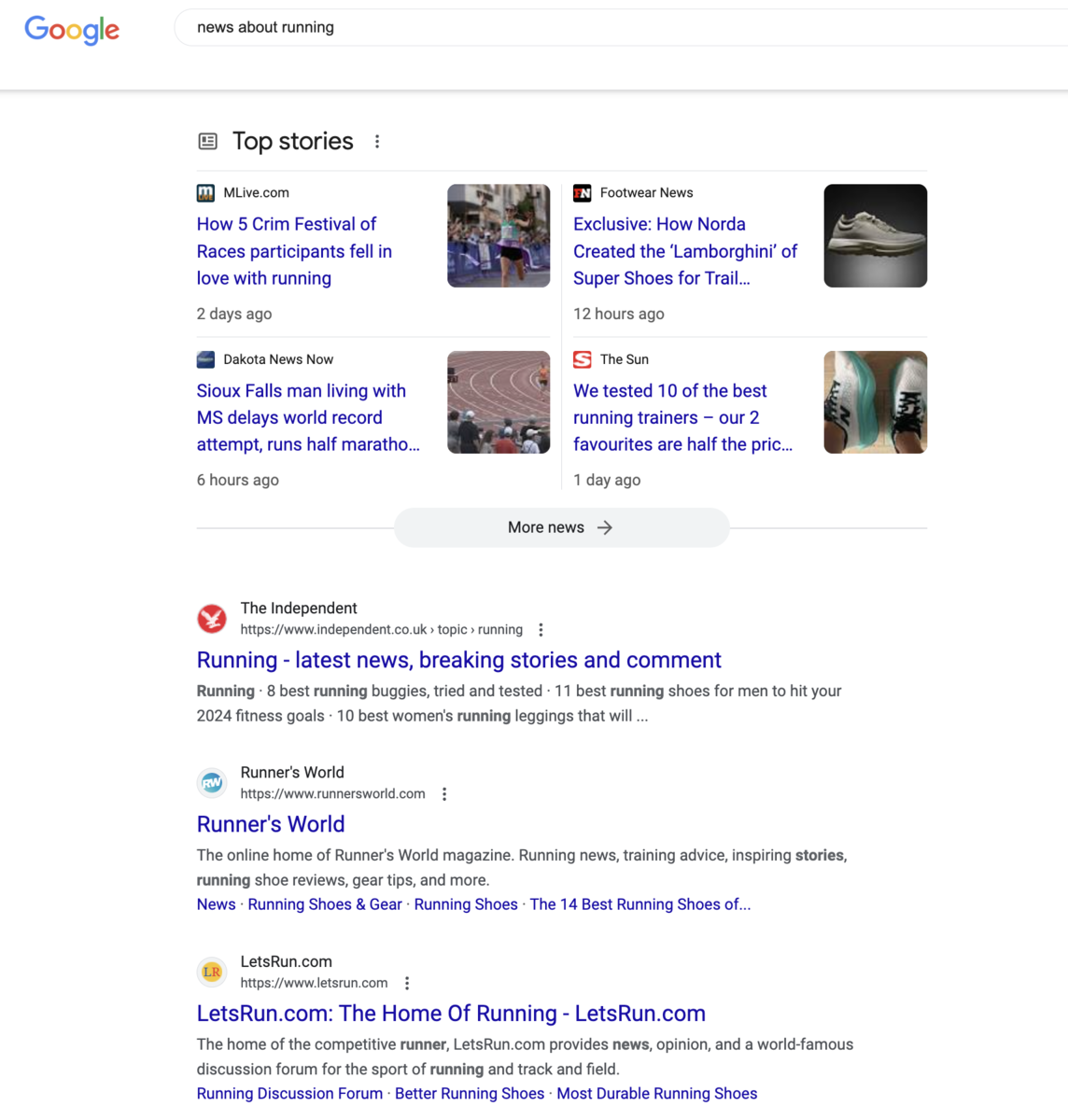
 Check out the BuzzStream Podcast
Check out the BuzzStream Podcast


